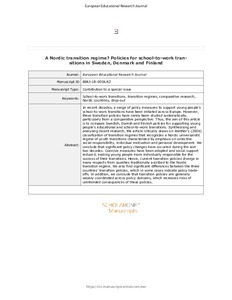A Nordic transition regime? Policies for school-to-work transitions in Sweden, Denmark and Finland
Christian Helms Jørgensen; Tero Järvinen; Lisbeth Lundahl
https://urn.fi/URN:NBN:fi-fe2021042822395
Tiivistelmä
In recent decades, a range of policy measures to support young people’s school-to-work
transitions has been initiated across Europe. However, these transition policies have rarely been
studied systematically, particularly from a comparative perspective. Thus, the aim of this article is
to compare Swedish, Danish and Finnish policies for supporting young people’s educational and
school-to-work transitions. Synthesising and analysing recent research, the article critically draws
on Walther’s (2006) classification of transition regimes that recognises a Nordic universalistic
regime of youth transitions characterised by emphasis on collective social responsibility, individual
motivation and personal development. We conclude that significant policy changes have occurred
during the last two decades. Coercive measures have been adopted and social support reduced,
making young people more individually responsible for the success of their transitions. Hence,
current transition policies diverge in many respects from qualities traditionally ascribed to the
Nordic transition regime. We also find significant differences between the three countries’
transition policies, which in some cases indicate policy trade-offs. In addition, we conclude that
transition policies are generally weakly coordinated across policy domains, which increases the risk of unintended consequences of these policies.
Kokoelmat
- Rinnakkaistallenteet [19207]
